Information/Write-up
When is a pair not a pair? When it's The Guess Who half of A Wild Pair.
Released in the spring of 1968, the Wild Pair album coupled The Staccatos, a quintet from Ottawa, on Side A with Winnipeg's favorite sons The Guess Who, Randy Bachman, Burton Cummings, Jim Kale, and Garry Peterson - on Side B. What you have in your hands is half that pair, plus some intriguing rare bonus tracks.
While the group's breakthrough album Wheatfield Soul with its stunning million-selling hit single These Eyes would launch The Guess Who as a group, along with the songwriting partnership of Bachman-Cummings, into the rock 'n' roll stratosphere the following year, A Wild Pair laid the all-important groundwork for that success. Frankly, the latter could not have happened without the former. Confirms veteran Canadian music journalist and Billboard correspondent Larry Leblanc, A Wild Pair, indeed, was a transition album for The Guess Who. Without it, and the confidence in their songwriting, there wouldn't have been Wheatfield Soul.
Just as Revolver had served notice of The Beatles creativity and imagination blossoming beyond the limited confines of the standard pop song format thus setting the stage for the brilliantly innovative pastiche of the Sgt. Pepper album, A Wild Pair's experimentation with orchestral instrumentation and arrangements coupled with burgeoning songwriting talent was the precursor to the polished professionalism of Wheatfield Soul.
And the catalyst for this transformation was, oddly enough, Coca-Cola. In the United States, pop stars pitching products had already proven to be a lucrative venture for Madison Avenue's ad agencies ever eager to tap into the teen market. Canada was a whole different story, however. Did we have our own legitimate homegrown pop sensations worthy enough to hitch a corporate logo to Canada barely had its own music industry let alone nationally-recognized stars. Toronto-based musician and jingle-writer Jack Richardson believed it was possible.
"I actually got involved with The Guess Who when I was with McCann-Erickson, the advertising agency for Coca-Cola," recalls Jack, on the start of what would become one of the most celebrated relationships in Canadian music history. ?We developed this youth radio campaign whereby we decided to use younger spokespeople for our product. We did a series of radio commercials using Canadian acts like JB and the Playboys, David Clayton Thomas, Robbie Lane and the Disciples. The jingles were based on the songs these artists were relatively well-known for and we ran them in 30, 60 and 90 second spots. The Guess Who was one of the acts we approached.
Already experienced hands at crafting jingles for the likes of Honda (Two-Wheel Freedom on a Honda) and, by the fall of 1967, established television stars on the Winnipeg edition of CBC-TV?s popular Let's Go show, The Guess Who was an obvious choice for the ad campaign. They were Canada's best-known group having cracked the American charts two years earlier with their hit Shakin' All Over. "One of our dreams had been to do a Coke commercial," notes guitarist and group leader Randy Bachman. "Ray Charles had done one and we thought it was cool." Jack brought The Guess Who to Toronto's Hallmark Studios to cut radio jingles for Coke incorporating the soft drink's signature slogan "Things go better with Coke!" into two of the group's biggest Canadian hits, Shakin' All Over and This Time Long Ago (the former included on this CD for the first time).
"The outcome of that," recalls Jack, "was that the agency recommended we put together a compilation album from the catalogues of these artists. I suggested it would be better to go with something original. The first one we did was with Bobby Curtola and it was so successful they decided to do it again. That became A Wild Pair with The Guess Who on one side and the Staccatos on the other."
What attracted Jack to the Winnipeg band? "The songs, they were good players, and I felt that Burton Cummings had a charismatic quality to him that seemed ready to explode," he remembers. "Having worked with them on the commercials and knowing that there were relatively few bands at that point in time that had any profile nationally across Canada, The Guess Who had that with the CBC television show and their previous records." Confirms Larry Leblanc, "There really wasn't another group on a national level like The Guess Who. All the other bands across the country were regional. The Guess Who were big across Canada."
The combination of Jack Richardson's studio savvy, arranging experience and commercial ear coupled with the talent and determination of the four Winnipeggers proved fortuitous and, ultimately, successful far beyond the imaginations of any of them at that point. 'I had been in the music business since 1947," recounts Jack, "and had worked with a lot of international performers in a lot of different studios and had more experience, probably more than most in the country at that time. So coming together was a very compatible situation for both of us. We both had something to offer."
In the meantime, The Guess Who continued in their role as resident band on Let's Go covering the hits of the day as well as slipping in some of their favourite numbers from the flowering psychedelic scene. Among those were the Yardbirds' searing blues shuffle The Nazz Are Blue that boasts the most amazing single note sustained guitar solo in music history (ably covered by Randy with his new innovation the Herzog pre-amplifier, developed with Garnet Amplifier's Gar Gillies) and Vanilla Fudge's pounding treatment of The Supremes' hit You Keep Me Hangin' On, both handled meticulously by The Guess Who revealing once again the group's uncanny ability to mimic the latest trends without missing a hook, lick or nuance. In the Winnipeg group's hands The Beatles' evergreen Hey Jude receives sympathetic treatment as does British rivals The Rolling Stones' return to a rockin' sound with the driving Jumpin' Jack Flash. Years of playing cover tunes had served The Guess Who well. Boasts Randy, "Not only did we play the songs perfectly, we sounded exactly like the records."
When the call came from Jack Richardson to provide suitable material for an entire album side, Randy and Burton jumped at the opportunity. "This was the first time Burton and I had a serious assignment or goal for songwriting," Randy enthuses. "Up to then it had been just dabbling with no set goal or usage. So when we were asked to do the Wild Pair album, it was a challenge to "go for our dreams" at being a Lennon-McCartney, Jagger-Richards, or Bacharach-David songwriting team. The plan was that both bands would record all original material. So we set to work every Saturday afternoon at Burton's Mom's house on Bannerman. It was a very prolific time for us both collaboratively and alone." Although ostensibly still writing individually, the seeds of the Bachman-Cummings team were already sown that fall. Each writer presented his ideas, whether fragments or completed songs - to the other for critique; from that the two began a fruitful collaboration.
"The Wild Pair album gave Randy and Burton a project where they had to provide sufficient original material for," attests Jack, "as opposed to just writing for the sake of writing. It was left to me to pick the best material to make a potentially successful album not only for them but for our client." Up for the challenge, the two budding songwriters submitted more than two dozen songs for Jack and his partner, arranger Ben McPeek, to consider. Of those, five were selected for the album while several others would ultimately appear a year or two later on Wheatfield Soul and Canned Wheat. The Wild Pair assignment had a profound impact on the two young musicians. Notes band mate Garry Peterson, "The relationship Randy and Burton enjoyed was closer than with the rest of us because they wrote together. Burton learned to write songs with Randy. They had so many experiences together and were closer."
Sessions convened at Toronto's three-track Hallmark Studios in late 1967. "I was pretty young then, eighteen or nineteen," muses Burton, "and I remember this feeling of being in the big time on those sessions." Randy concurs. "Studios were in their infancy in Canada. Winnipeg didn't have any, so for us to go to a studio in Toronto was a big deal." For the first time in the group's lengthy recording career they would have the full gamut of musical resources at their disposal. Used to a "get in, set up, record and get out in three hours" regimen, now they could take their time and experiment with a variety of instruments and accompaniment, and the results would be mind-blowing. "There was a thirty-piece orchestra on that album," boasts Burton, "a lot of strings and horns. We even had the harp player from The Friendly Giant on the sessions." Ben McPeek provided the orchestral arrangements. "Ben was a very well-respected Toronto music arranger," notes Randy, "who had done symphonic pieces as well as commercials. He took our songs and added strings and horns."
Burton recalls another feature that marked the sessions. "I remember huge coolers of Coca-Cola on ice everywhere we looked in the studio. Tons and tons of Coke."
Up first is Randy’s majestic I Need Your Company, described by him as “my attempt at being Jimmy Webb using major seventh chords. Burton’s vocal on that was absolutely perfect and the orchestration was understated enough to compliment the song. The middle eight was me copying You’ve Lost That Lovin’ Feeling. “ Indeed, Burton renders his most sensitive vocal performance to that point in his recording career. The song closes out with his invocation to the sax man to play the song out as it kicks into a whole other gear in a jazzy fade showcasing drummer Garry Peterson’s versatility.
Bachman-Cummings collaboration, is a whimsical number boasting the group’s signature vocal harmonies alongside a full brass section. Reminiscent of Spanky and Our Gang’s hits, Randy suggests, “Burton and I were trying to write a Turtles kind of Happy Together song with that one. “ Very Far From Near offers Burton’s own interpretation of British pop pioneers Cliff Richard and the Shadows’ style of ballad featuring another example of his tremendous vocal abilities, with some subtle wah-wah guitar from Randy in the background. At the height of the group’s later success, Burton would come to be acknowledged far and wide as possessing the finest voice in rock music, a claim well-supported on A Wild Pair. In addition, if you listen to the choruses of each song you can clearly hear the voice of bass player Jim Kale whose harmonies were often at the core of the Guess Who’s hallmark vocal blend.
The group’s earlier jingles work with Jack had introduced them to the cream of the Toronto session players, many of whom returned for the Wild Pair sessions. “We got to work with the Toronto A team, “ Randy recalls, “the top players on the scene mostly from the jazz world like Guido Basso, Ed Bickert, Don Thompson, and Moe Kaufman. “, notes Garry Peterson, “These guys were really heavy jazz cats, great players. At that time a lot of jazz players would look down their noses at rock ‘n’ roll players but they were really nice to us. We had a lot of fun hanging out with these guys in the studio. They were great guys. “ One session player stood out above the others. “We were introduced to Hagood Hardy, “ remembers Burton, who along with Randy was moved to compose a song around the acclaimed piano/vibraphone player’s unusual moniker. “The name Hagood Hardy was so unique. That was a name that wasn’t exactly Jim Smith. I thought it was cool and figured “Let’s make up some gobbledy-gook lyrics using that name.’’ Chuckles Randy, “Burton and I each wrote a song around his name. Burton’s was better than mine, we both knew it, so we cut it for the album. I did some incredible Hendrix style guitar with my Herzog and wah-wah pedal but it was mixed out. I was disappointed they only left a little bit in the fade out. Heygoode Hardy was really over the top in terms of arrangement with wild trumpets everywhere. “
The closing track, Randy’s gorgeous ‘Somewhere Up High’, is his attempt to emulate the baroque-rock style of New York group The Left Banke. “That song was my own Walk Away Renee with cellos, “ he admits. Suggests Burton, “Somewhere Up High had these beautiful string lines that were very reminiscent of George Martin and what he did with the Beatles. “ Bathed in lush orchestration, the song offers a fitting conclusion not only to The Guess Who’s tracks but to the Wild Pair album itself.
A further key ingredient in the overall sonorous sound quality and impact of the album was the recruitment of an engineer from New York. “Jack brought in a new young mixer, “ recalls Randy, and we said, “What's a mixer? We had never worked with one before. We learned that he balances the sounds between the instruments. The guy turned out to be Phil Ramone who we met for the first time. That's why ‘A Wild Pair’ sounds so darn good. The sound is incredible.” Though Ramone would go on to enjoy tremendous success with artists like Billy Joel, the Wild Pair sessions were memorable for him. “Jack hired me and I thought it was kind of fun that the groups were doing a record as a giveaway for promotion,’ he recalls. ‘I think we did one band on one day, and the other the next. We only had so many hours. “
With sessions completed, The Guess Who returned to Winnipeg and resumed their weekly duties on Let’s Go. They had already debuted the five Wild Pair tracks on the show prior to the sessions, featuring orchestral arrangements provided by CBC music director Bob McMullin (heard here for the very first time on CD). Soon after, Coca-Cola began promoting the album in earnest across Canada. Not available in record stores, fans purchased A Wild Pair by mailing in twelve Coca-Cola bottle cap liners and a dollar. Within a matter of months the album had sold over 80,000 copies, a staggering sum for the fledgling Canadian music industry, largely without the benefit of radio support, notes Larry Leblanc. “Radio played little of it, certainly in Toronto. There was little promotion of the package to Canadian radio programmers. The only promotion involved was advertising on TV and radio spots sponsored by Coke. “
“We couldn’t get a gold record for it because it wasn’t sold through retail outlets, “ laments Randy, “but it was one of the biggest selling albums in Canada up to that point. “ Jack sites another positive outcome of the album’s triumph. “The Wild Pair album was one of the reasons The Guess Who stayed together, “ he suggests, “because at that time they were on the verge of breaking up due to severe economic straits. “ The group was still straining under the weight of a crippling debt from their ill-fated trip to Britain.
The unprecedented success of ‘A Wild Pair’ was the first indication that a viable national Canadian music industry could, indeed, exist. “That was quite a feat for the Canadian market, “ stresses Jack. “Back then it was really the birth of an industry in Canada. “ It also rang bells with Jack and his partners. “I felt there was a tremendous amount of talent in the group and that became the motivation behind us taking the flyer and forming Nimbus 9 Productions. We approached both the Staccatos and The Guess Who with the idea of coming with us as a production group. The Guess Who agreed and we bought out their Quality Records contract for $1000. The Staccatos chose to stay with Capitol Records, so it was one of those “win one, lose one“ situations. But I think we won the best one. “ Phil Ramone agrees. “Jack was totally enamoured with the fact that the band was so good, “ he maintains. “We all were. They were just incredible. Burton had his own vocal sound, a radio-friendly voice that you can pick out of the crowd, and made that sound become a part of his identity. He didn’t imitate anybody else. “
The impact of the album on The Guess Who’s climb to the top cannot be understated. “Following the success of A Wild Pair, “ recalls Randy, “Jack informed us that he wanted to do an entire album with us and instructed Burton and I to write more songs. That was validation for us that we were songwriters. And we, in turn, had confidence in Jack. He saw something in us that no one else did, or would admit to, and was willing to put his money where he was mouth was. He was willing to gamble on the band and that really floored us. “ Jack would mortgage his own house to finance sessions in New York later that year for Wheatfield Soul. “To him, we were worth the risk, “ he adds.
The first order of business was a single to capitalize on A Wild Pair’s success. The group returned to Hallmark Studios in Toronto to cut several tracks including the Bachman-Cummings compositions Of a Dropping Pin and When Friends Fall Out. “When Friends Fall Out is a little masterpiece, “ offers Randy, “the beat, the solos, the bridge with all of us singing like the Strawberry Alarm Clock. “ The track was backed by the rockin’ Guess Who Blues, a number that recounts the group’s many ups and downs over the previous years and boasts some blistering Claptonesque guitar playing from Randy. Although both singles failed to make much headway on the Canadian charts, Jack believed the band needed an album to showcase their diverse sounds so sessions were booked at A&R Studios in New York in mid-September 1968. He then approached RCA in New York.
“Nimbus had a distribution deal with RCA in Canada, “ relates Jack, “and Of a Dropping Pin was the first single. Although it wasn’t a huge success, Andy Nagy at RCA in Montreal felt there was something there and called his head office in New York. I flew to New York to meet with Don Burkhimer at RCA based on the single Of a Dropping Pin. There was no mention of an album in the pipeline, we had just completed it. Don wasn’t aware of the album. I brought along an acetate of Wheatfield Soul and after our conversation, I asked him if he would mind listening to it and giving me his opinion. Don sat and listened to the entire record, which was very unusual for an A and R man, let me tell you, and when it was done he looked at me and said ‘Jack, These Eyes is a smash hit.’ I came back to Canada and told the boys that we were going with These Eyes as the single, that RCA felt the same way, and that we had a potential deal with them on that basis. That’s where it all started and Of a Dropping Pin was the entrée so to speak. “
“As you can see by these tracks, we were still learning to write by emulating songs we loved, “ surmises Randy. “There was a transition after this where we became better at it and the next batch of songs we wrote was the These Eyes batch where the influences were left more behind. We now had confidence in our own ideas with only hints of other songs. But the magnitude of A Wild Pair on our evolution was immeasurable. The album was a further step up in terms of our level of sophistication. Burton and I honed our writing skills and it introduced us to Jack Richardson who gave our sound a whole new context. “ The degree of songwriting maturity and arranging over a mere eighteen months, from Believe Me and If You Don’t Want Me to Somewhere Up High and Very Far From Near, represents an extraordinary creative quantum leap that would continue to blossom over the next two years. Clearly, Randy and Burton were now painting from a far richer, more colourful palette.
"Everything was incremental," muses Randy, "from His Girl, to the London This Time Long Ago sessions with Tony Hiller, to A Wild Pair with Jack Richardson. Working with producers who knew what they were doing was a huge step for us."
The release of the Wild Pair tracks on CD draws the final curtain on The Guess Who's early career. On the strength of these initial recordings with Jack Richardson, the group would sign to RCA Records in New York and never look back (a countrified take on Close Up The Honky Tonks is also included here for the first time, one of the rarest of Guess Who tracks and a joke recorded during the American Woman sessions to tease RCA executives). What followed A Wild Pair would forever alter the Canadian music landscape, as well as the lives of the four young men in The Guess Who.
-John Einarson is the author of American Woman: The Story Of The Guess Who and Randy Bachman: Takin' Care of Business co-written with Randy Bachman. 2012
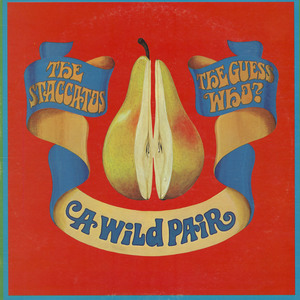
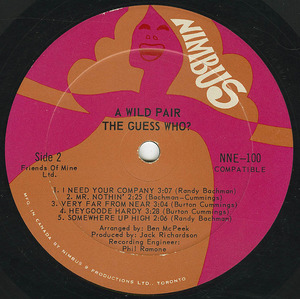
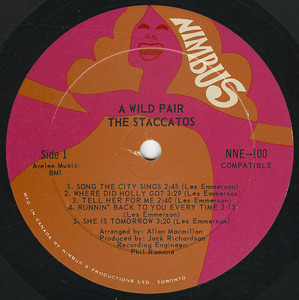
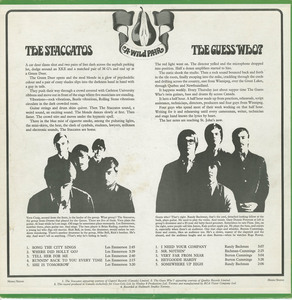
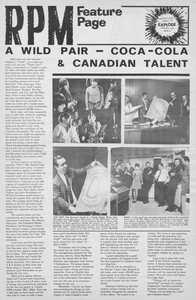
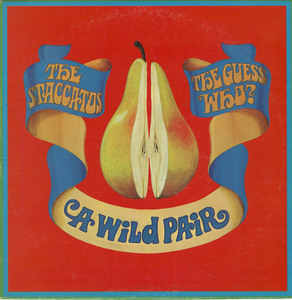
No Comments